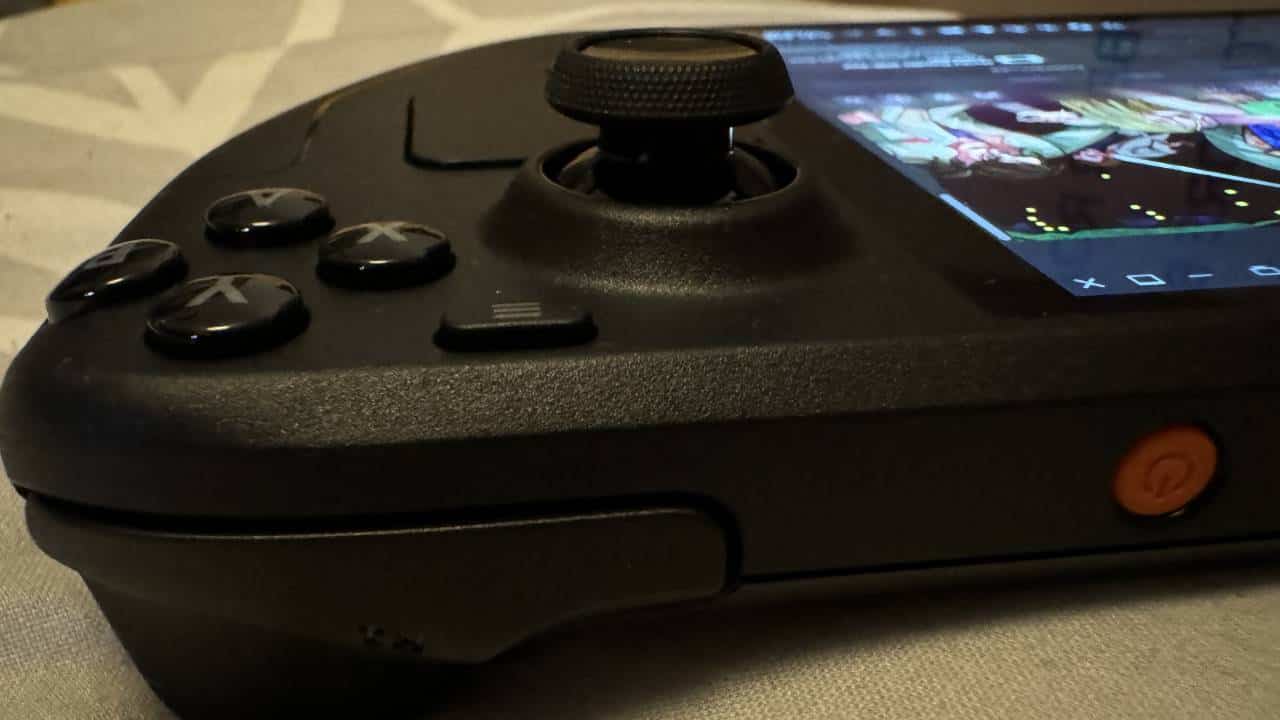You can trust VideoGamer. Our team of gaming experts spend hours testing and reviewing the latest games, to ensure you're reading the most comprehensive guide possible. Rest assured, all imagery and advice is unique and original. Check out how we test and review games here
- Gorgeous OLED panel
- Powerful performance
- Competitively priced
- Stellar game support
- Can get warm in heavy use
- Linux has its quirks
I’m going to cut right to the chase and tell you that the Steam Deck OLED is easily one of the best handheld games consoles on the market right now. Armed with a stunning display, intelligent quality of life improvements, an easy to navigate software, and exceptional software support, for the vast majority of people, this is the handheld gaming PC to get in 2023.
Valve has gone through quite the journey in the nearly two years since the original Steam Deck model launched. In those early days it was a revolutionary idea being able to play your PC games whenever you wanted no strings attached. However, as the competition has arisen in this time frame from the likes of AyaNeo, ASUS, and Lenovo, the creator of the digital distribution giant has reclaimed its throne.
Steam Deck OLED review: Price and availability
The Steam Deck OLED is available now in territories such as the US and the UK with a starting retail price of $549 / £479 for the 512GB model and $649 / £569 for the 1TB variant. It’s worth stating that this is the same base price that you would have paid at launch for the 512GB LCD model around 18 months ago so I have to give some serious credit to Valve for keeping the rates of the hardware so competitive while sprucing up the display and internals the way it did.
This is especially pivotal when considering the price of the competition as it stands in 2023. That’s because the ASUS ROG Ally’s base version retails for $599 / £599 with the Z1 Extreme iteration costing $699 / £699 unless discounted on sale. The same can be said for the Lenovo Legion Go which starts at $699 / £700. It really puts into perspective just how cost-effective the Steam Deck OLED seems in comparison with its new panel type and higher SSD capacity.
Steam Deck OLED review: Design and Features

The design of the Steam Deck OLED is virtually identical to the base model released last year, at least on the surface. That means you’re greeted with a panel backed with dual trackpads, a D-pad, twin analog sticks, triggers, bumpers, and stereo speakers in an ergonomic package. Look a little closer, however, and you’ll see where things begin to deviate.
That’s because the Steam Deck OLED not only features the panel type of its namesake, but the screen itself is slightly larger at 7.4 inches. What’s more, this display is HDR enabled with a contrast rating of 1,000,000:1 and a peak brightness of 1000 nits with a 110% color gamut. This is in direct contrast to the original model’s 400 nits and duller IPS LCD display; a massive jump. It’s the same 1280x800p sub-Full HD full resolution, but it looks incredible given size of the screen.
You can expect a smoother experience on the new OLED model thanks to its faster refresh rate of 90Hz which is an increase of 50% from the 60Hz of the first iteration. The new handheld can benefit from deep blacks and far more vivid colors with more accurate representation than previously, but the changes don’t stop there.
Valve also tweaked the internals in some meaningful ways, too. While the core hardware remains the same, an AMD Zen 2 APU armed with RDNA 2 graphics and 16GB DDR5 RAM, things have been dialled here. That’s because the latest variant is built on a 6nm process with the RAM clocked slightly higher at 6,400 MT versus 5,550 that came before.
A major advancement has been the connectivity options of the Steam Deck OLED which now features support for Bluetooth 5.3 for controllers and accessories, but also Wi-Fi 6E which replaces the first run’s Wi-Fi 5 dual-band. This means you can expect your games to download much faster if you’ve got high speed internet to take advantage.
Then there’s the battery life being greatly improved too thanks to the inclusion of a 50Whr battery inside. Valve states you can expect anywhere from three to 12 hours of gameplay depending on the software intensity which is a mammoth improvement from the original’s 40Whr battery that could average anywhere from two to eight hours of playback. That means you’re potentially in for around 50% more game time here which is seriously impressive. What’s more, the Steam OLED is actually a touch lighter than the first iteration with a weight of 640g compared to 669g.
Capacity has also seen an increase as well. Valve is now offering the Steam Deck OLED in either 512GB or a new 1TB version, with plans to phase out the original LCD 512GB variant while stocks last. The latter option is the one you’ll want to aim for if you’re after as much space for games as possible, particularly at a time where some single titles on Steam are pushing upwards of 100GB or more.
Steam Deck OLED review: Performance

I’ve been consistently impressed by what the Steam Deck OLED has been able to do in my time with the handheld console. What’s immediately noticeable from the jump is just how big of a difference the new bright and vivid OLED screen is when playing games on the platform. Naturally, my first instinct was to head out to my vast Steam library and download all my favorite titles, and I found myself quickly won over by just how much better everything looks and feels when in motion.
As someone who’s had a ton of hands-on experience with the original Steam Deck, playing the new OLED variant genuinely feels like an entirely new experience from the jump. It all comes down to just how good the deep blacks and the popping colors can look. Take Otxo for instance, a monochrome roguelike inspired by Hotline Miami with its deep blacks permeating every inch of the playable field. The darkness is conveyed so sharply and accurately that I actually prefer playing it handheld versus on my HDR 1000 enabled gaming monitor.
This extends to going through the likes of Alan Wake and Metal Gear Rising Revengeance with their darker color palettes and bleak aesthetics being accurately captured by the handheld. It’s the same wow factor I had picking up the PlayStation Vita or the Nintendo Switch OLED model for the first time but with far more technically advanced software.
Color is where the Steam Deck OLED really shines, though. I was immediately blown away by how stunning Mortal Kombat 1 and Sonic Mania looked on this handheld. That’s thanks to the high contrast panel combined with the significantly brighter display of 1000 nits which made playing in bed, in transit, and out and about a joy. It’s even gotten to the point where I’ll take it around the house to get a few gaming hours in between lunch breaks, after work, and on weekends instead of getting at my computer or kicking back in front of the PS5 which I was not expecting.

Valve claims anywhere from three to 12 hours of playback depending on the intensity of the software played, and I can verify this is accurate for the most part. When I was playing the likes of Sonic Mania, Otxo, Papers Please, and Hotline Miami, the Steam Deck OLED wouldn’t break a sweat, only losing around 10% of battery life in around an hour. However, things did pick up a lot more when going through Mortal Kombat 1 and Fallout: New Vegas which were draining the battery. I clocked around three hours for the former and about four and a half hours for the later with minimal battery saving tweaks which isn’t bad going all told.
What I personally find so exciting about the Steam Deck OLED is that it’s a portable PC that also doubles as a gaming console and I’ve had a great time exploring Linux in desktop mode. This is where the excellent dual trackpads on either side of the device come into play, delivering a far more accurate experience than solely relying on analog sticks. It’s especially needed when scrolling through websites, watching videos, and experimenting with what the OS can do.
As it’s not a Windows 11 based machine as with its competitors, there will be some games and services that are not as commonly supported. Any game with an anti-cheat system such as Overwatch 2, Call of Duty: Modern Warfare 3, and Destiny 2 doesn’t exactly play nice with Linux, but that’s not necessarily a downside of the Steam Deck’s infrastructure. As someone who’s used the ASUS ROG Ally in the past and found its software to be a little troublesome, I would trade the simplicity of the SteamOS and how the launcher works for a little more range with what I can play.
Should you buy the Steam Deck OLED?
The Steam Deck OLED is a triumph from Valve who managed to meaningfully upgrade its game-changing PC handheld from the first of its kind to the definitive model for the majority of people. If you’re after only raw bleeding edge prowess in 1080p then perhaps a competitor would be a better fit, however, considering the price-to-performance ratio and that stunning display, this is the handheld which I can thoroughly recommend. Whether you have an extensive library of Steam games already or want a cost-effective way to play titles on the platform without breaking the bank, this model strikes all the right notes.

